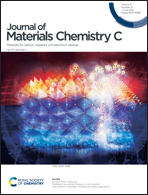Organoboron compounds constructed through the tautomerization of 1H-indole to 3H-indole for red OLEDs†
Abstract
Through the tautomerization of 1H-indole to 3H-indole caused by triphenylboron, the electron-accepting 3H-indole group and the electron-donating N atom of an arylamino group are integrated into a π-conjugated fused-ring skeleton. The special π-skeleton endows the synthesized complexes with bright orange–red/red emission. The bulky substituents on the π-skeleton, which are unfavorable for intermolecular π-stacking, serve as a factor for suppressing the fluorescence concentration quenching. Owing to the rational molecular design, a red organic light-emitting diode (OLED) with one of these complexes doped in an exciplex-forming co-host achieved simultaneously a high external quantum efficiency of up to 10.2% and a Commission Internationale de L'Eclairage (CIE) coordinate of (0.620, 0.371), which is close to the CIE coordinate of (0.67, 0.33) of the red primary defined by the National Television System Committee (NSTC). The combination of such high efficiency and good colour coordinate on exciplex-hosted red OLEDs of the traditional fluorescent emitters is rarely achieved. This study opens the application of the 3H-indole group in the OLED materials and discloses the role of suppressing concentration quenching on the challenging combination of high efficiencies and good colour coordinates on exciplex-hosted red fluorescent OLEDs.



 Please wait while we load your content...
Please wait while we load your content...